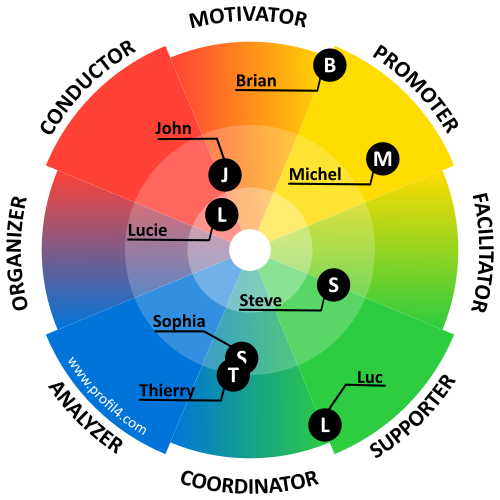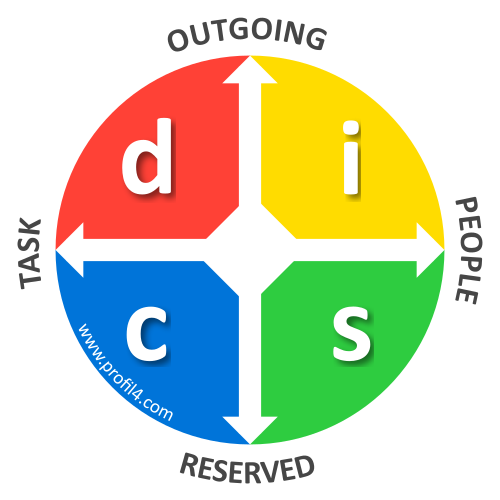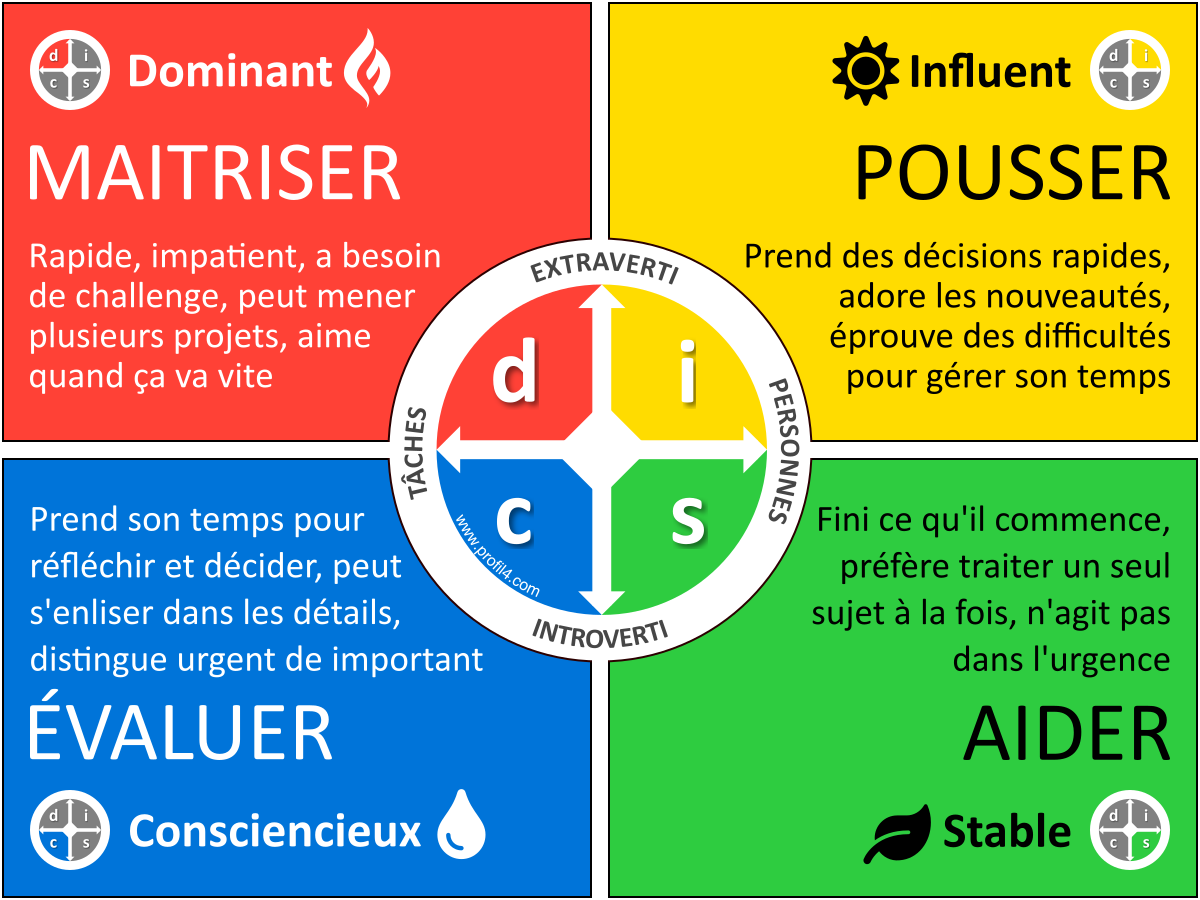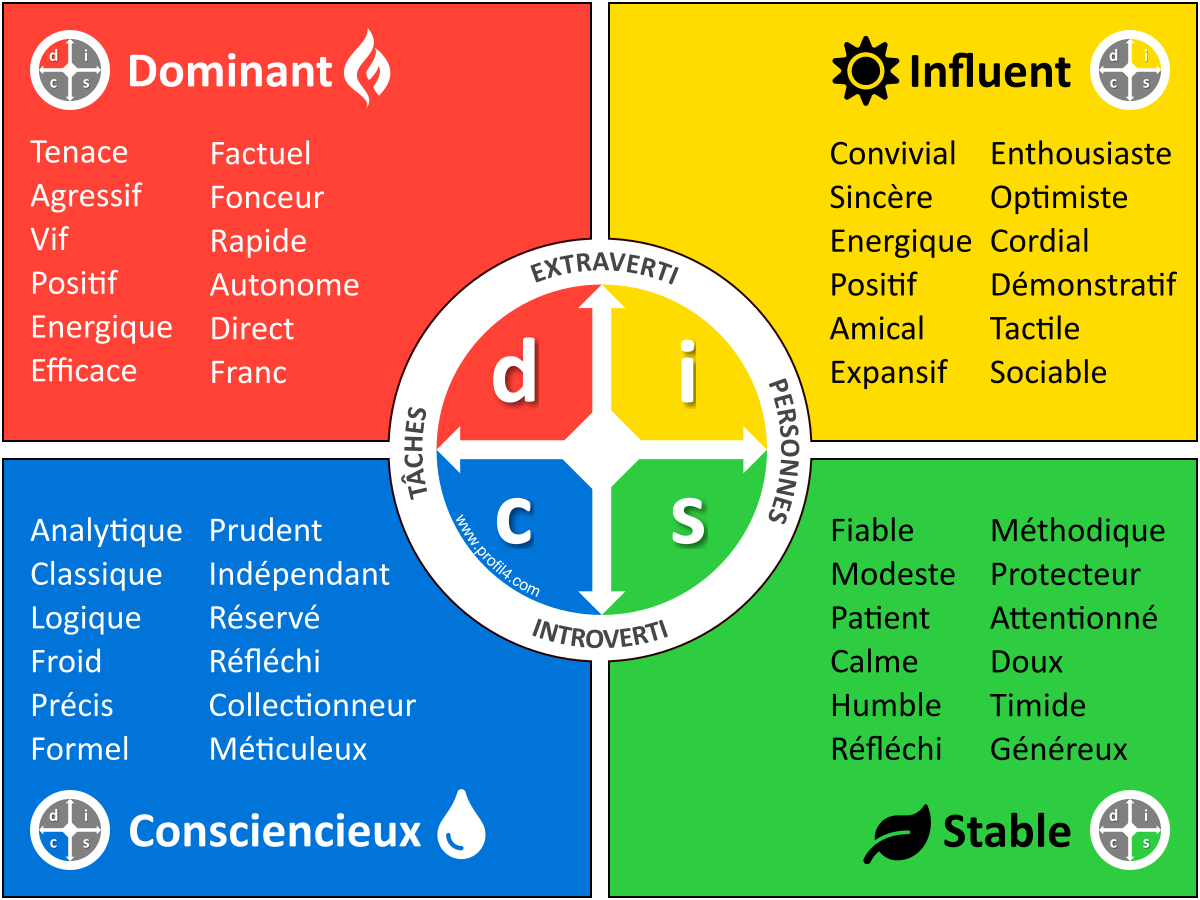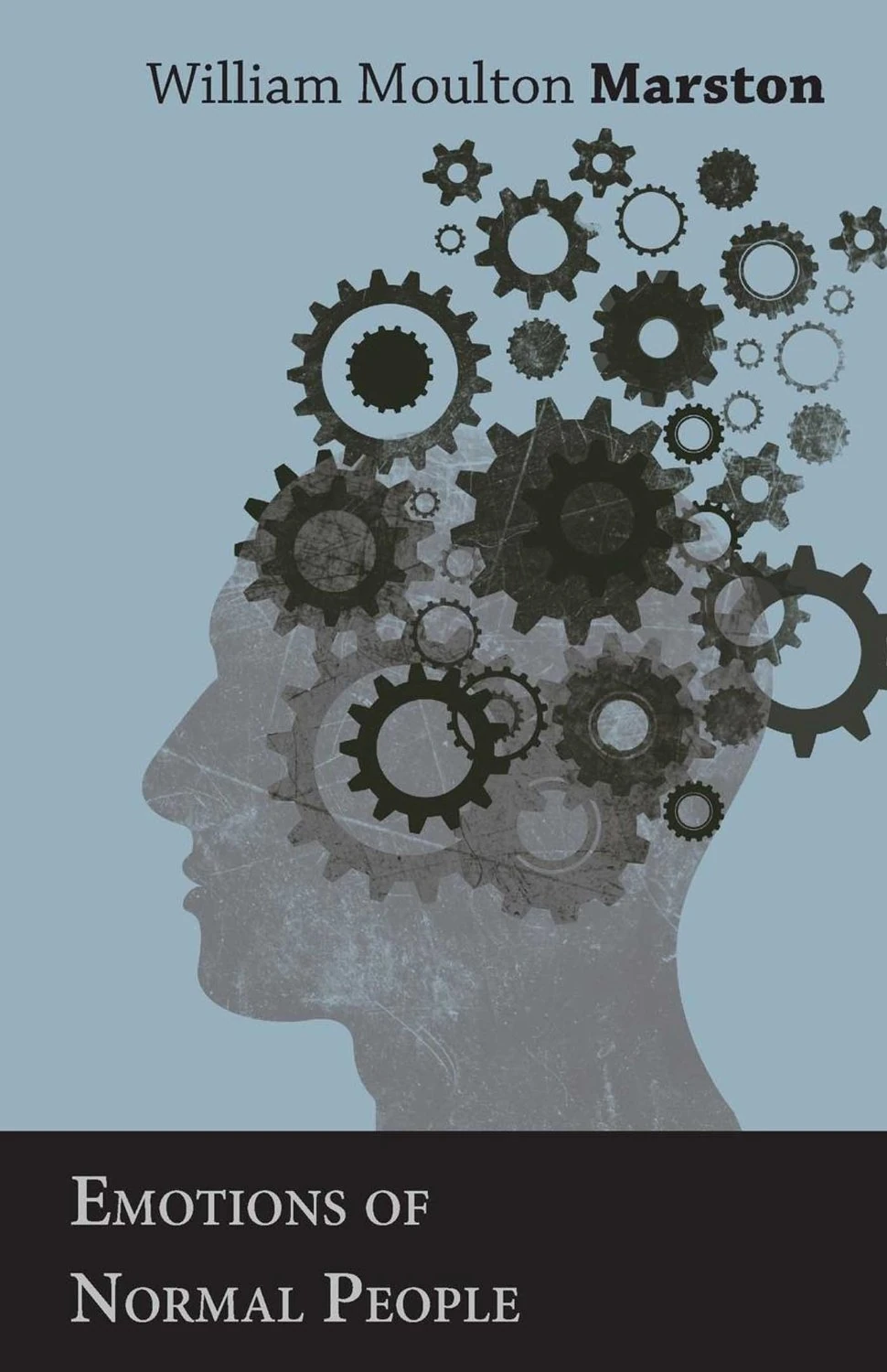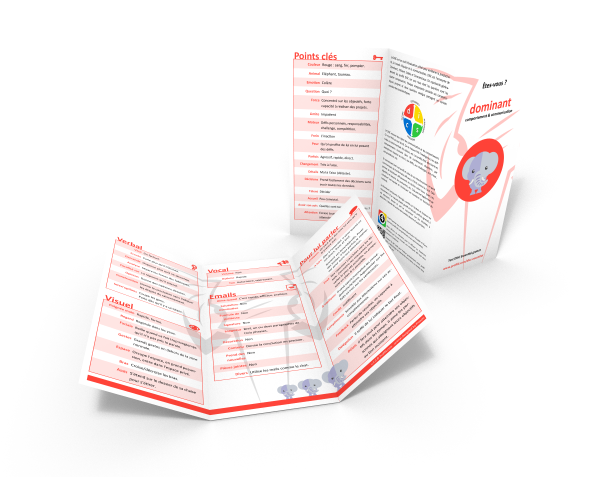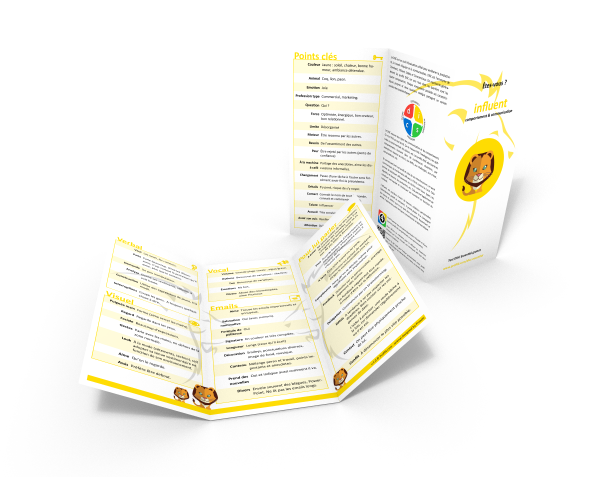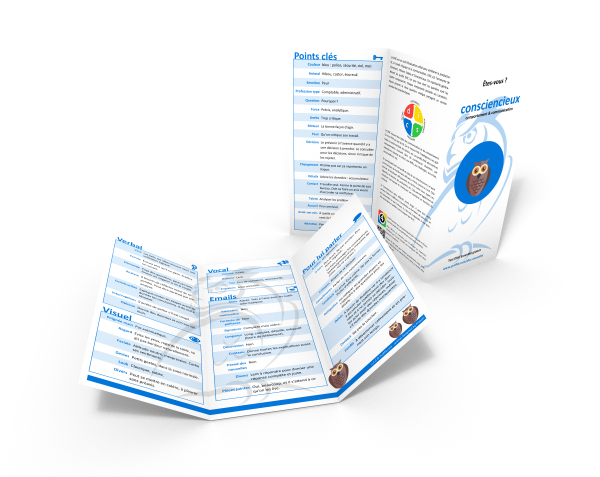The DISC color wheel
Origins of the DISC
The red profile: dominant
The yellow profile: influent
The green profile: stable
The blue profile: Conscientious
8 trends
Communication and Behavior
Motivations - ODAPHIS index
Conflict management
Stress management
Managing mistakes
Improving your sales pitch
Management
At work
Chronoplanning
Vidéos et podcasts
Further research
DISCp4 is an assessment tool designed to optimize productivity, teamwork and communication. It focuses exclusively on the analysis of behavioral and communication styles.
The golden rule of communication is to adapt to the needs and styles of others.
We often make the fundamental mistake of talking to others the way we'd like them to talk to us. However, others expect us to speak to them in the way they prefer. Unconsciously, everyone wants other people to adapt to them.
It's the same within a team.
Team members may share common goals or projects, but each of them is unique, with their own viewpoint, expectations, needs and communication style. To achieve a collective goal, everyone applies their own approach to analyzing and discussing the project then moving forward. This can sometimes lead to conflict, often due to simple misunderstandings.
The DISCp4 model helps understand others.
Designed for both individuals and teams, DISCp4 teaches people how to adapt effectively to the communicative needs of their contacts. It fits perfectly into an Agile approach, promoting optimal communication.
It is essential to note that DISCp4 is a grid for reading human behavior. It is neither an IQ test, nor a measure of intelligence, skills, etc. It cannot be considered an assessment of personal values, but rather a study of behavioral styles.
The D.I.S.C. model to the letter
DISCp4, an acronym for Dominant, Influential, Stable and Conscientious, is a grid for interpreting and understanding how a person reacts and interacts with their environment.
DISCp4 profiles are usually presented on a color wheel divided into four quarters, each representing one of the components: Dominant (red), Influential (yellow), Stable (green) and Conscientious (blue). Each quarter has its own characteristics, but adjacent quarters share common traits. For example, the Dominant (D) and Influential (I) profiles are typically associated with extraverted traits.
The DOMINANT profile is characterized by an overflow of energy, a resolute focus on action, and constant dynamism. Naturally inclined to a positive, pragmatic attitude, although they may sometimes be perceived as aggressive, they are endowed with an extroverted temperament and great perseverance as well as a strong drive for achieving results. In their interactions, they adopt a direct and authoritative approach towards others.
The INFLUENTIAL profile places great importance on building strong, satisfying personal relationships. Typically positive and outgoing, they enjoy the company of others and believe that life should be a source of pleasure. With their warm, friendly attitude, they interact with others in a convincing, democratic way, radiating enthusiastic energy.
The STABLE profile is characterized by their seriousness and reliability. They value constancy in their lives, and can show great determination in defending a cause. They are often uncomfortable with impersonal structures and ambiguous situations. In their interactions, they come across as reserved or shy.
The CONSCIENTIOUS profile prefers to think before they act. This tendency can sometimes be misinterpreted as coldness or indifference. They have a strong inclination to seek knowledge and figure out their environment. They may find it difficult to deal with pressure from above and have a definite preference for written communication.
Adapted profile and Natural profile
In addition to its four main components, the DISC model identifies two behavioral styles: the Adapted Style and the Natural Style.
The Adapted Style represents our "public self", the image we project in response to our environment. Carl Jung referred to this as "the mask": a version of ourselves shaped to meet external expectations, social roles, or situational demands.
In contrast, the Natural Style reflects our "private self". It represents the most stable and instinctive part of our personality—the way we behave when we are not consciously trying to adapt. Less influenced by external factors, it reveals our deeper, often unconscious behavioral tendencies.
In other words, the natural style shows who we truly are, while the adapted style reveals how we try to be perceived or how we respond to our environment. It is perfectly common—and entirely normal—for these two styles to differ. This simply indicates that the person, consciously or not, is trying to adjust to their context (team, role, responsibilities, constraints, etc.). For example, an accountant may emphasize conscientiousness, a salesperson might try to appear more outgoing, and a manager may adopt a more authoritative stance.
However, if the gap between the two styles is too wide, it could suggest that the person overthought their answers during the assessment. In such cases, it’s best to wait a while and retake the test, responding more spontaneously for a more accurate result.
How it works
DISCp4 profiles are easy to use, both for employees and managers.
The tool includes a series of questions, such as "In life, you have to get up in the morning, in order to [...]", and asks the user to select from several simple answers the one that corresponds to them the best. The test, which lasts around fifteen minutes, should be carried out in a quiet place without any interruptions.
Results are calculated immediately.
They show the how each of the four components is represented proportionally in the user's adapted and natural profiles. Depending on the test taken, graphs and a report (see sample reports) may also be also provided. A feedback session and further explanations can be provided if the user books an appointment.
Assessments
DISCp4 assesses your communication and behavioral styles.
It is important to emphasize that this is NOT an IQ test and does NOT measure intelligence, skills, mental health, personal values, etc. The DISCp4 is designed to describe human behavior in a variety of situations, such as when they are dealing with stress, facing challenges, in crisis, following procedures or in other similar circumstances.
DISCp4 results are reliable.
They are based on rigorous research into behavioral characteristics which has been ongoing since the 1920s.
You'll learn to adjust your responses according to the profile of your contacts or the situation. This may include choosing not to use the behavioral style which is is the most comfortable to you, but rather that which will be most effective for communicating with others.
Origins (Marston and Clarke)
The DISC model was elaborated on the basis of William Moulton Marston's work.
This American psychologist is also known as the creator of the Wonder Woman character and the polygraph. In 1928, he published "Emotions of Normal People". In this seminal work, he explains how emotions lead to differences in behavior between groups of people and how a person's behavior can change over time. His work focused on directly observable and measurable psychological phenomena.
Marston explained that the behavioral expression of emotions can be classified into four primary components, stemming from a person's self-perception in relation to their environment. These four components are those found on the DISCp4 wheel.
His work inspired Walter V. Clarke's personality test.
An industrial psychologist, Clarke was the first to construct an assessment tool (personality test) using Marston's theories. In 1956, he published "the Activity Vector Analysis" (AVA), a list of adjectives that he presented to people, asking them to identify those that corresponded to them the best. The tool, which Clarke had been using since 1948, was designed to help companies select staff. It draws directly on Marston's work and focuses on four factors: aggressiveness, sociability, emotional control and adaptability.
Benefits
More effective communication thanks to knowing your own profile and that of your contacts.
For example, a person with a Dominant (D) profile, who is generally energetic, will benefit from speaking calmly when addressing a person with a Stable (S) profile.
More targeted management.
Understanding the DISCp4 profile of your employees helps you to assign tasks more strategically, taking into account specific objectives and constraints. It also facilitates more appropriate communication, both orally and in writing, but particularly by email, by respecting the specificities of each profile. In addition, it makes it possible to build a team by selecting its members optimally according to the context.
Mementos
Mementos sum up the main characteristics of the DISCp4 profiles. They are the ideal complement for understanding test results and adapting your communication to the context.

